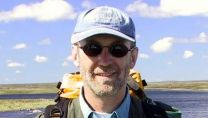
Doug Currie
Senior Curator of Insects & Arachnids
Exhibitions & Galleries: Life in Crisis: Schad Gallery of Biodiversity
Phone: 416.586.5532
Bio
B.Sc. (Honours), Zoology, University of Alberta, 1978
Ph.D., Entomology, University of Alberta, 1988
Doug Currie is Vice-President, Department of Natural History and Senior Curator of Entomology at the ROM and Associate Professor in the Department of Ecology & Evolutionary Biology at the University of Toronto.
Doug’s Ph.D. dissertation, Morphology and Systematics of Primitive Simuliidae, examined the early evolutionary relationships of black flies — a notorious pest of birds and mammals. He joined the ROM in 1993 after post-doctoral fellowships at the University of British Columbia in Vancouver, British Columbia (1990 – 1992) and the Canadian National Collection of Insects and Arachnids in Ottawa, Ontario (1992 – 1993). He is actively engaged in teaching at the graduate- and undergraduate levels through his cross-appointment to the University of Toronto.
Doug’s research interests are focused on the systematics and comparative biology of aquatic insects, with special reference to black flies. His emphasis on aquatic organisms maintains a long-standing focus of ROM entomology, which includes the research collections of Edmund M. Walker (1918 – 1968, dragonflies and damselflies) and Glenn B. Wiggins (1952 – present, caddisflies). Doug continues to study the morphology and systematics of world black flies, but now includes cutting-edge approaches to help address long standing species-identity problems. His current research focuses on the diversity and biogeography of northern Holarctic black flies, and is based on material collected from major expeditions to Nunavut, Northwest Territories, Yukon Territory, Alaska and eastern Siberia. Doug’s recent book The Black Flies (Simuliidae) of North America — co-authored with Peter H. Adler and D. Monty Wood — received the Association of American Publishers Award for Best Single-Volume Reference in the Sciences in 2004.
